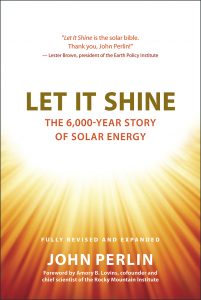Book Review: Let It Shine – The 6000 Year Story of Solar Energy

Reviewed by Rebecca Canright.
Rahus Institute-Solar Schoolhouse. 20171111
John Perlin’s Let it Shine proves that solar energy has powered human communities long before the dawn of photovoltaic technology. Nowadays we consider solar an “alternative” form of energy, but Perlin’s in-depth analysis illustrates that it has not always been that way.
Perlin’s account of the history of humankind’s relationship with the Sun would serve as a reliable teaching tool for high school and college classes in environmental science, engineering, and science history. It is a trusty must-read for anyone entering the solar industry who seeks a deeper understanding of our ancient experiments with sun energy. Students interested in engineering will learn how numerous advanced civilizations have tapped into this abundant resource to warm their water, food, and homes, to enhance their quality of life, and most recently, to generate electricity. Students interested in political studies will learn of the ability of government to make or break the advancement of solar energy technology, especially in the last couple centuries. Even middle-school science teachers could integrate excerpts of Let It Shine into their classes’ studies of energy and natural resources. Accompanied by hands-on experiments with solar ovens, solar phone chargers, or a field trip touring a passive-solar residence or rooftop photovoltaic array, Perlin’s historical solar stories will provide students of all ages with insight into the Sun’s enormous potential to fulfill our energy needs.
This book needs to be in the hands of the next generation of engineers, architects and political decision-makers so that we can learn from history and harness the truly limitless capacity of solar energy. Our communities can thrive not only through the widespread adoption of rooftop photovoltaic systems, but also through the implementation of the simpler solar technologies of the ancients, like passive solar architecture. Imagine the energy saved and comfort gained if all new homes were built with south-facing windows and reliable insulation! We are speedily depleting our once-abundant fossil fuel reserves, and given their climate change-accelerating consequences, we would be wise to educate our youth, heirs to the energy problem we have created, about the solutions that lie in the orb in the sky.

Perlin takes us on a journey through the ages as humans have harnessed the power of the sun, focusing heavily on the evolution of passive solar home design around the world. From heating the famous Roman baths, thereby reducing the need for charcoal, to sustaining the post-medieval European penchant for greenhouse cultivation of exotic plants, to providing hot water for innumerable 19th and 20th century homes, all the way up to the invention of photovoltaics, Perlin leaves no stone of the solar story unturned.

His analysis reveals that solar knowledge has varied widely among different civilizations. Within societies like the U.S. and Europe especially, the use of solar building and heating techniques has fluctuated with sociopolitical changes; for instance, people of the Middle Ages largely forgot the earlier Greek and Roman knowledge of orienting buildings toward the sun to keep warm in winter. More recently, as oil, natural gas, and nuclear power entered the energy scene of the 1900s, government investment in solar faltered severely. The reader learns how a perceived abundance of cheap fossil fuel has been many times interrupted with sudden scarcity—and a renewed interest in solar “alternatives” inevitably follows. One cannot help but sympathize with solar, the ever-present energy underdog, waiting to be realized as the genuinely endless, harmless power source. We learn of other insightful nations’ rewarding solar ventures: from Israel and Denmark’s heavy reliance upon the Sun for hot water, to Japan and Germany’s widespread incentivization of rooftop solar, to African villages’ achievement of energy independence thanks to micro-arrays of photovoltaic panels. Perlin also thoroughly covers the research-based improvements made to solar technology over the centuries, recounting for us the challenges faced and victories won by numerous engineer and architect solar champions, including Leonardo Da Vinci, Bernard Christoph Faust (German advocate for the sonnenstadt, or utopian solar city), Freeman Ford (hippie entrepreneur of solar pool heaters in the 1970s), and countless others who recognized both the risk of conventional fuel shortages and the bounteous rewards of tapping into the original source of all light, heat, and energy on our planet.

Perlin’s tone when recounting the successes of the various solar pioneers is decidedly optimistic, and rightfully so: these are moments in history when humanity recognized the potential for thriving, resilient solar communities, and acted upon it. Despite the inevitable naysayers and obstacles hindering the path to widespread solar prosperity, the one crucial ingredient—the Sun—has not gone anywhere (and won’t be, for a while, anyway). It shines patiently as humans grapple with other more fluctuating, finite forms of energy, until we (hopefully) arrive at the sensible conclusion that there really is no other light at the end of the tunnel except the one that has been here all along.

Anyone who questions our current energy system and who seeks the solar path will learn a great deal from John Perlin. After reading Let it Shine, I regard the brilliant orb in the sky with much more awe and gratitude. It has sustained humans (and countless other life forms) for eons, and with luck, will keep our planet humming for many more. The decision to transition to a fossil fuel-free future (and thereby save the lives of our children) rests largely in our hands. Yes, government plays an important role in encouraging the transition, but we as individuals can climb aboard the train of solar revolution whether the political powers that be are with us, or not. Given the threat that global climate change poses to humanity’s continued survival, I reckon that if we want to stick around, we had best tap into our very own cosmic power plant. Thanks, John Perlin, for eloquently shedding light on the long line of foresightful advocates of the Sun. May many more of us join their ranks.

